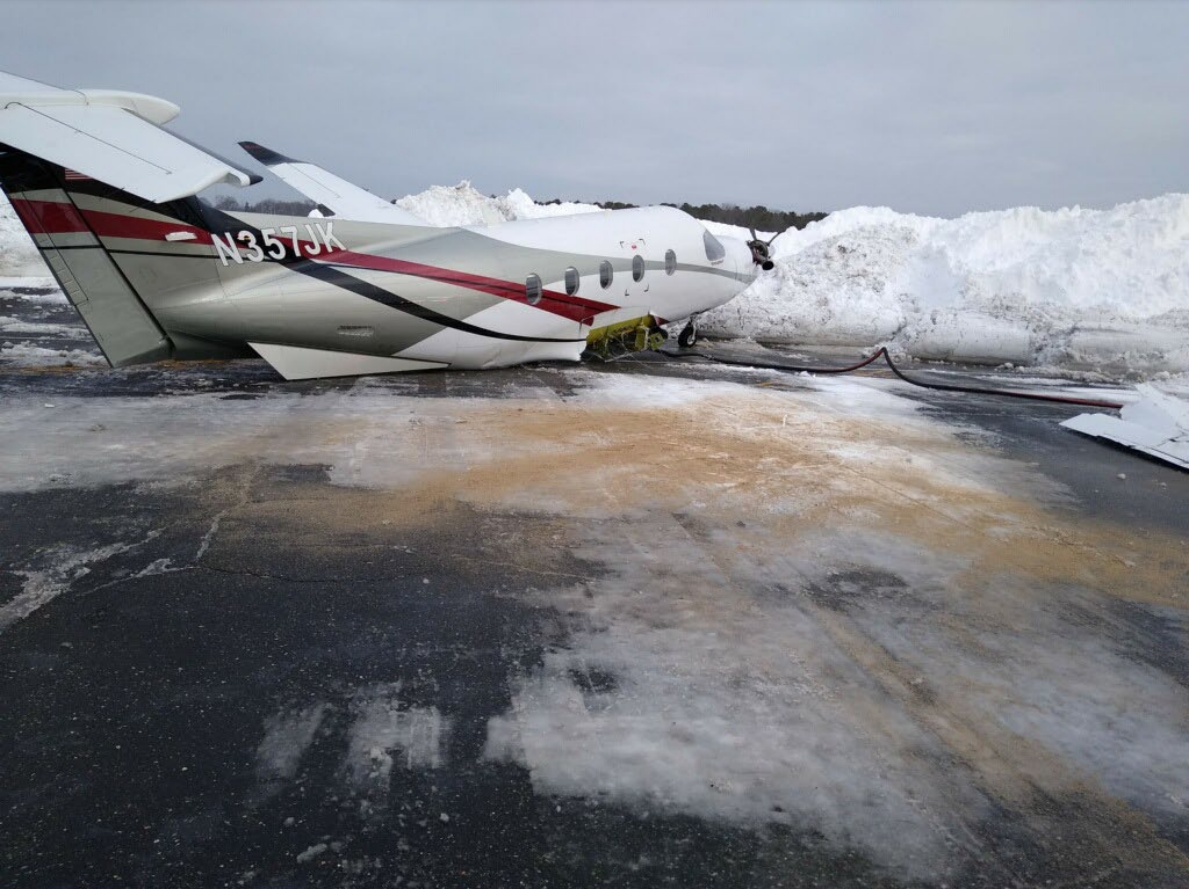
You can contribute by submitting additional or updated information.
| Date: | Wednesday 2 February 2022 |
| Time: | 06:55 |
| Type: |  Pilatus PC-12/47E |
| Owner/operator: | AGF Capital LLC |
| Registration: | N357JK |
| MSN: | 1451 |
| Year of manufacture: | 2013 |
| Total airframe hrs: | 1749 hours |
| Engine model: | P&W Canada PT6A-67 |
| Fatalities: | Fatalities: 0 / Occupants: 2 |
| Other fatalities: | 0 |
| Aircraft damage: | Substantial |
| Category: | Accident |
| Location: | Islip-Long Island MacArthur Airport (ISP/KISP), Ronkonkoma, NY -
 United States of America United States of America
|
| Phase: | Standing |
| Nature: | Ferry/positioning |
| Departure airport: | Islip-Long Island MacArthur Airport (ISP/KISP), NY |
| Farmingdale-Republic Airport, NY (FRG/KFRG) | |
| Investigating agency: | NTSB |
| Confidence Rating: |
On February 2, 2022, about 0655 eastern standard time, a Pilatus PC-12/47E, N357JK, was substantially damaged when it was involved in an accident at Long Island MacArthur Airport (ISP), Ronkonkoma, New York. The commercial pilot and a pilot-rated passenger were not injured. The airplane was operated as a Title 14 Code of Federal Regulations (CFR) Part 91 personal flight.
The pilot and a pilot-rated passenger were starting the engine before a positioning flight. The airplane’s cockpit voice recorder captured some checklist usage; however, there was no comment for the position of the power control lever (PCL) in the “Cockpit” checklist. Although the checklist specified and the pilot reported that the PCL was in the idle position at engine start, based on the flight data recorder (FDR) data, it was not in the idle position at any time during the engine start or accident sequence. After the engine was started with the parking brake engaged and the pilot’s application of normal toe brakes, the airplane accelerated on the ramp to a maximum speed of 26 knots and briefly attained a maximum propeller speed of 1,870 rpm, which was likely due to the cold engine oil temperature, but well within rpm and time limits. The pilot was unable to stop the airplane on the ramp, which likely contained ice, or to move the condition lever (CL) to stop the engine, and the airplane impacted a parked, unoccupied airplane, resulting in substantial damage.
Although cockpit rigging checks of the PCL and CL showed out-of-tolerance conditions, rigging checks at the engine for those controls and for the cut-off guard of the CL in the cockpit revealed no evidence of preimpact failure or malfunction that would have precluded a normal engine start. There were no discrepancies with the fuel control unit that would have caused the engine acceleration issue at engine start, and there were no discrepancies with the parking brake or the left brake. Although testing of the right brake was not performed due to separation of the right wing, there was no evidence of preimpact failure or malfunction of the brakes or parking brake that contributed to the collision. While there was no flat-spotting of either main landing gear tire, alternating skid marks on the ramp were likely due to the ice on the ramp.
Recorded data from a previous, uneventful engine start performed by the accident pilot with the PCL in the idle position revealed normal engine parameters. Testing of an exemplar airplane with the PCL in the correct position at engine start (idle) and the CL in either ground or flight idle positions during engine start revealed little forward movement with no brakes applied.
The PCL was found in a forward position following the accident. Although the exact position of the PCL at engine start could not be determined from the FDR information, based on the maximum engine and propeller parameters recorded by the FDR, and the speed the airplane reached before the collision, it is likely that the PCL was nearly fully advanced during the engine start. Had the pilot performed a flow check then reviewed the checklists for any missed items or engaged the passenger to perform challenge-and-response to the entire checklist, the incorrect position of the PCL could have been detected and corrected before engine start.
Though the pilot reported being unable to secure the CL while accelerating and approaching the parked airplane, there were no reported discrepancies with the cut-off guard, or of the CL during postaccident operational testing. Therefore, the pilot’s unsuccessful attempt to secure the CL were likely due to errors made while multitasking when presented with an unexpected situation (airplane acceleration during engine start and being unable to stop the airplane) while fast approaching a parked airplane.
Probable Cause: The pilot’s failure to properly position the power control lever before starting the engine as required per the checklist. Contributing to the accident were the ice on the ramp and the pilot’s failure to secure the engine using the condition lever.
Accident investigation:
 |
|
Sources:
https://www.newsday.com/long-island/transportation/plane-hits-jet-macarthur-airport-1.50497030
https://aviapages.com/aircraft/n357jk/
https://data.ntsb.gov/Docket?ProjectID=104590
https://registry.faa.gov/AircraftInquiry/Search/NNumberResult?nNumberTxt=357JK
Location
Images:

Photo: NTSB
Revision history:
| Date/time | Contributor | Updates |
|---|---|---|
| 02-Feb-2022 18:30 | Captain Adam | Added |
| 02-Feb-2022 19:24 | harro | Updated [Narrative, ] |
| 04-Feb-2022 03:25 | johnwg | Updated [Time, Total occupants, Departure airport, Source, Narrative, Category, ] |
| 03-Apr-2022 16:41 | Captain Adam | Updated [Time, Nature, Destination airport, Source, Narrative, Category, ] |
| 14-Mar-2024 21:16 | Captain Adam | Updated [Time, Location, Phase, Source, Narrative, Accident report, Photo, ] |
Corrections or additions? ... Edit this accident description
The Aviation Safety Network is an exclusive service provided by:


 ©2025 Flight Safety Foundation
©2025 Flight Safety Foundation